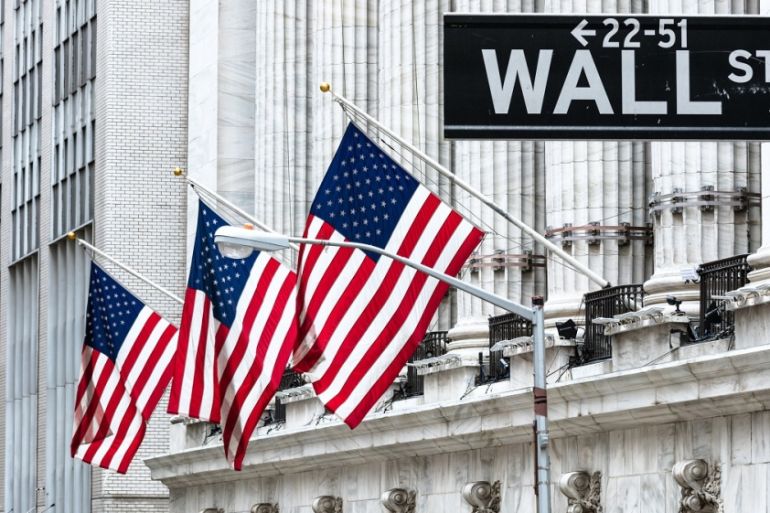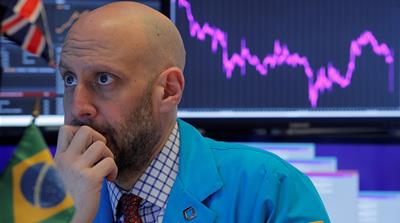Sea of Red: US stocks hammered on coronavirus fears
S&P 500, Dow register their biggest one-day percentage drop since February 2018.

Wall Street’s three major stock indexes tumbled on Monday on coronavirus fears. Investors looked for safety on intensifying worries about the global economic impact of the viral outbreak after a surge in cases outside China fanned worries about a possible pandemic.
The Dow Jones Industrial Average fell 1,029.5 points, or 3.55 percent, to 27,962.91. The S&P 500 lost 111.8 points, or 3.35 percent, to 3,225.95. The Nasdaq Composite dropped 355.31 points, or 3.71 percent, to 9,221.28.
Keep reading
list of 3 itemsNeighbours close borders with Iran as virus concerns rise
Asian stocks, currencies fall sharply as coronavirus cases surge
The step drops comes after a rise in coronavirus cases in Iran, Italy and South Korea over the weekend fed fears that the outbreak could have a bigger impact than originally anticipated on global economic growth.
Though US stocks pared initial losses, the DJIA is still negative for the year. And Wall Street’s so-called “fear gauge” – the CBOE’s VIX volatility index – reached its highest level since August.
Iran, which announced its first infections last week, said it had reported 61 cases and 12 deaths, with most cases in the holy city of Qom.
Kuwait, Bahrain, Afghanistan, Iraq and Oman on Monday reported their first infections from the coronavirus, which has killed more than 2,600 globally, with the vast majority of victims in China.
In Italy, seven deaths have been reported in the country’s north and the number of confirmed cases has risen to more than 220, prompting emergency measures in Europe.

“The idea that the coronavirus has been fully contained has been firmly banished,” Chris Beauchamp, the chief market analyst at IG. “This means the economic forecasts of the impact, such as they are, will need to be revised, with a greater impact now to be expected.”
In Europe, Milan’s stock market nosedived more than 5.5 percent after a spike in cases of the virus killed six people in Italy and left parts of the country’s industrial north in virtual lockdown.
Frankfurt and Paris fell more than 4 percent and London’s FTSE dropped 3.8 percent, wiping at least $400bn off the region’s market value in a few short hours.
In commodity markets, oil came under pressure again as investors tried to get to grips with how the widening outbreak could affect energy demand both within China – the world’s largest oil exporter – and throughout the world.
Oil pared some of its early losses. US crude fell 3.6 percent to $51.46 per barrel and Brent was last at $56.38, down 3.62 percent on the day.
Among the main industrial metals, Copper lost 1.33 perent to $5,688.50 a tonne.
As investors punished stocks and oil, they fled towards safe-haven assets like gold, government bonds and select currencies.
Gold surged 2.5 percent to a seven-year high of $1,680 an ounce.
Bonds rallied with yields – which move in the opposite direction to prices – on US treasuries falling below 1.36 percent for the first time since July 2016. The 30-year US Treasury bond touched a record low at just below 1.81 percent and German yields dropped to -0.48 percent, their lowest in more than four months.
“Everybody sees that this could be another leg down for the economy, and we were already in quite a fragile state, to begin with,” said Rabobank’s head of macro strategy, Elwin de Groot. “It could be another step towards a recession in more countries.”
Foreign exchange markets reacted by pushing up the safe-haven Japanese yen to 111.34 units per dollar. But against the rest of the world, the dollar was again showing its strength.
The euro was squeezed towards $1.08 and the Australian dollar – often traded as a proxy for China risk – fell to an 11-year low of $0.6585.